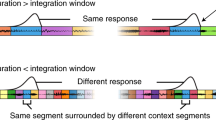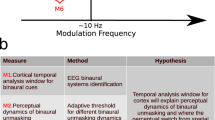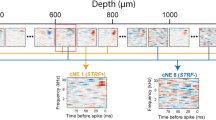Abstract
Because auditory cortical neurons have limited stimulus-synchronized responses, cortical representations of more rapidly occurring but still perceivable stimuli remain unclear. Here we show that there are two largely distinct populations of neurons in the auditory cortex of awake primates: one with stimulus-synchronized discharges that, with a temporal code, explicitly represented slowly occurring sound sequences and the other with non-stimulus-synchronized discharges that, with a rate code, implicitly represented rapidly occurring events. Furthermore, neurons of both populations displayed selectivity in their discharge rates to temporal features within a short time-window. Our results suggest that the combination of temporal and rate codes in the auditory cortex provides a possible neural basis for the wide perceptual range of temporal information.
This is a preview of subscription content, access via your institution
Access options
Subscribe to this journal
Receive 12 print issues and online access
$209.00 per year
only $17.42 per issue
Buy this article
- Purchase on Springer Link
- Instant access to full article PDF
Prices may be subject to local taxes which are calculated during checkout




Similar content being viewed by others
References
Rosen, S. Temporal information in speech: acoustic, auditory and linguistic aspects. Phil. Trans. R. Soc. Lond. B Biol. Sci. 336, 367–373 (1992).
Margoliash, D. Acoustic parameters underlying the responses of song-specific neurons in the white-crowned sparrow. J. Neurosci. 3, 1039–1057 (1983).
Doupe, A. J. & Konishi, M. Song-selective auditory circuits in the vocal control system of the zebra finch. Proc. Natl. Acad. Sci. USA 88, 11339–11343 (1991).
Wang, X., Merzenich, M. M., Beitel, R. & Schreiner, C. E. Representation of a species-specific vocalization in the primary auditory cortex of the common marmoset: temporal and spectral characteristics. J. Neurophysiol. 74, 2685–2706 (1995).
Esser, K.-H., Condon, C. J., Suga, N. & Kanwal, J. S. Syntax processing by auditory cortical neurons in the FM-FM area of the mustached bat Pteronotus parnellii. Proc. Natl. Acad. Sci. USA 94, 14019–14024 (1997).
Whitfield, I. C. Auditory cortex and the pitch of complex tones. J. Acoust. Soc. Am. 67, 644–647 (1980).
Heffner, H. E. & Heffner, R. S. Effect of unilateral and bilateral auditory cortex lesions on the discrimination of vocalizations by Japanese macaques. J. Neurophysiol. 56, 683–701 (1986).
Zatorre, R. J. Pitch perception of complex tones and human temporal-lobe function. J. Acoust. Soc. Am. 84, 566–572 (1988).
Heil, P. Auditory cortical onset responses revisited. I. First-spike timing. J. Neurophysiol. 77, 2616–2641 (1997).
de Ribaupierre, F., Goldstein, M. H. Jr. & Yeni-Komshian, G. Cortical coding of repetitive acoustic pulses. Brain Res. 48, 205–225 (1972).
Eggermont, J. J. Rate and synchronization measures of periodicity coding in cat primary auditory cortex. Hear. Res. 56, 153–167 (1991).
Cheung, S. W. et al. Auditory cortical neuron response differences under isoflurane versus pentobarbital anesthesia. Hear Res. 156, 115–127 (2001).
Creutzfeldt, O., Hellweg, F.-C. & Schreiner, C. Thalamocortical transformation of responses to complex auditory stimuli. Exp. Brain Res. 39, 87–104 (1980).
Phillips, D. P., Hall, S. E. & Hollett, J. L. Repetition rate and signal level effects on neuronal responses to brief tone pulses in cat auditory cortex. J. Acoust. Soc. Am. 85, 2537–2549 (1989).
Gaese, B. H. & Ostwald, J. Temporal coding of amplitude and frequency modulation in the rat auditory cortex. Eur. J. Neurosci. 7, 438–450 (1995).
Bieser, A. & Müller-Preuss, P. Auditory responsive cortex in the squirrel monkey: neural responses to amplitude-modulated sounds. Exp. Brain. Res. 108, 273–284 (1996).
Steinschneider, M., Reser, D. H., Fishman, Y. I., Schroeder, C. E. & Arezzo, J. C. Click train encoding in primary auditory cortex of the awake monkey: evidence for two mechanisms subserving pitch perception. J. Acoust. Soc. Am. 104, 2935–2955 (1998).
Lu, T. & Wang, X. Temporal discharge patterns evoked by rapid sequences of wide- and narrowband clicks in the primary auditory cortex of cat. J. Neurophysiol. 84, 236–246 (2000).
Johnson, D. H. The relationship between spike rate and synchrony in responses of auditory-nerve fibers to single tones. J. Acoust. Soc. Am. 68, 1115–1122 (1980).
Joris, P. X. & Yin, T. C. T. Responses to amplitude-modulated tones in the auditory nerve of the cat. J. Acoust. Soc. Am. 91, 215–232 (1992).
Kilgard, M. P. & Merzenich, M. M. Plasticity of temporal information processing in the primary auditory cortex. Nat. Neurosci. 1, 727–731 (1998).
Plomp, R. Rate of decay of auditory sensation. J. Acoust. Soc. Am. 36, 277–282 (1964).
Ronken, D. A. Monaural detection of a phase difference between clicks. J. Acoust. Soc. Am. 47, 1091–1099 (1970).
Goldstein, M. H. Jr., Kiang, N. Y.-S. & Brown, R. M. Response of the auditory cortex to repetitive acoustic stimuli. J. Acoust. Soc. Am. 31, 356–364 (1959).
Wang, X. On cortical coding of vocal communication sounds in primates. Proc. Natl. Acad. Sci. USA 97, 11843–11849 (2000).
Mardia, K. V. & Jupp, P. E. Directional statistics (John Wiley and Sons, New York, 2000).
Patterson, R. D. The sound of a sinusoid: spectral models. J. Acoust. Soc. Am. 96, 1409–1418 (1994).
Fay, R. R., Chronopoulos, M. & Patterson, R. D. The sound of a sinusoid: perception and neural representations in the goldfish (carassius auratus). Audit. Neurosci. 2, 377–392 (1996).
Lu, T., Liang, L. & Wang, X. Neural representations of temporally asymmetric stimuli in the auditory cortex of awake primates. J. Neurophysiol. 85, 2364–2380 (2001).
Langner, G. Periodicity coding in the auditory system. Hear. Res. 60, 115–142 (1992).
Shadlen, M. N. & Newsome, W. T. Noise, neural codes and cortical organization. Curr. Opin. Neurobiol. 4, 569–579 (1994).
Ahissar, E., Sosnik, R. & Haidarliu, S. Transformation from temporal to rate coding in a somatosensory thalamocortical pathway. Nature 406, 302–306 (2000).
Fitzpatrick, D. C., Kuwada, S., Kim, D. O., Parham, K. & Batra, R. Responses of neurons to click-pairs as simulated echoes: auditory nerve to auditory cortex. J. Acoust. Soc. Am. 106, 3460–3472 (1999).
Wang, X. & Sachs, M. B. Transformation of temporal discharge patterns in a ventral cochlear nucleus stellate cell model: implications for physiological mechanisms. J. Neurophysiol. 73, 1600–1616 (1995).
Schulze, H. & Langner, G. Periodicity coding in the primary auditory cortex of the Mongolian gerbil (meriones unguiculatus): two different coding strategies for pitch and rhythm? J. Comp. Physiol. A 181, 651–663 (1997).
Miller, G. A. & Taylor, W. G. The perception of repeated bursts of noise. J. Acoust. Soc. Am. 20, 171–182 (1948).
Hirsh, I. J. Auditory perception of temporal order. J. Acoust. Soc. Am. 31, 759–767 (1959).
Joliot, M., Ribary, U. & Llinas, R. Human oscillatory brain activity near 40 Hz coexists with cognitive temporal binding. Proc. Natl. Acad. Sci. USA 91, 11748–11751 (1994).
Brown, C. H. & Maloney, C. G. Temporal integration in two species of old world monkeys: blue monkeys (cercopithecus mitis) and grey-cheeked mangabeys (cercocebus albigena). J. Acoust. Soc. Am. 79, 1058–1064, 4 (1986).
Moody, D. B. Detection and discrimination of amplitude-modulated signals by macaque monkeys. J. Acoust. Soc. Am. 95, 3499–3510 (1994).
Resnick, S. B. & Feth, L. L. Discriminability of time-reversed click pairs: intensity effects. J. Acoust. Soc. Am. 57, 1493–1499 (1975).
Green, D. M. Temporal acuity as a function of frequency. J. Acoust. Soc. Am. 54, 373–379 (1973).
Patterson, R. D. The sound of a sinusoid: time-interval models. J. Acoust. Soc. Am. 96, 1419–1428 (1994).
Akeroyd, M. A. & Patterson, R. D. A comparison of detection and discrimination of temporal asymmetry in amplitude modulation. J. Acoust. Soc. Am. 101, 430–439 (1997).
Flanagan, J. L. & Guttman, N. On the pitch of periodic pulses. J. Acoust. Soc. Am. 32, 1308–1319 (1960).
Schouten, J. F., Ritsma, R. J. & Cardozo, B. L. Pitch of the residue. J. Acoust. Soc. Am. 34, 1418–1424 (1962).
Krumbholz, K., Patterson, R. D. & Pressnitzer, D. The lower limit of pitch as determined by rate discrimination. J. Acoust. Soc. Am. 108, 1170–1180 (2000).
Aitkin, L. M., Merzenich, M. M., Irvine, D. R., Clarey, J. C. & Nelson, J. E. Frequency representation in auditory cortex of the common marmoset (callithrix jacchus jacchus). J. Comp. Neurol. 252, 175–185 (1986).
Aitkin, L. & Park, V. Audition and the auditory pathway of a vocal new world primate, the common marmoset. Prog. Neurobiol. 41, 345–367 (1993).
Rauschecker, J. P., Tian, B. & Hauser, M. Processing of complex sounds in the macaque nonprimary auditory cortex. Science 268, 111–114 (1995).
Acknowledgements
The authors thank E. Bartlett and S. Kadia for helpful comments on the manuscript and A. Pistorio for assistance with animal training. This work was supported by NIH Grant DC03180 and by a Presidential Early Career Award for Scientists and Engineers (X. Wang).
Author information
Authors and Affiliations
Corresponding author
Rights and permissions
About this article
Cite this article
Lu, T., Liang, L. & Wang, X. Temporal and rate representations of time-varying signals in the auditory cortex of awake primates. Nat Neurosci 4, 1131–1138 (2001). https://doi.org/10.1038/nn737
Received:
Accepted:
Published:
Issue Date:
DOI: https://doi.org/10.1038/nn737
This article is cited by
-
Parvalbumin neurons enhance temporal coding and reduce cortical noise in complex auditory scenes
Communications Biology (2023)
-
High Spectral and Temporal Acuity in Primary Auditory Cortex of Awake Cats
Journal of the Association for Research in Otolaryngology (2023)
-
Developmental Exposure to Bisphenol a Degrades Auditory Cortical Processing in Rats
Neuroscience Bulletin (2022)
-
Intracellular neuronal recording in awake nonhuman primates
Nature Protocols (2020)
-
Propagation of temporal and rate signals in cultured multilayer networks
Nature Communications (2019)



